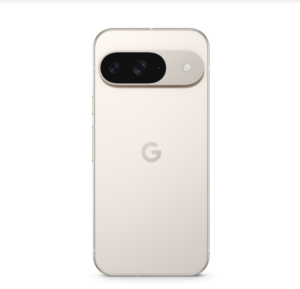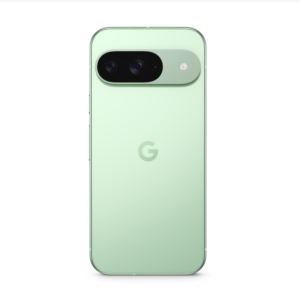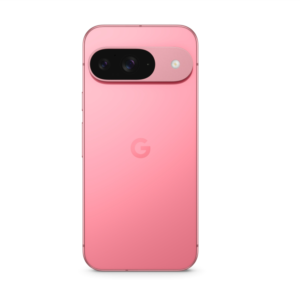Google Pixel 9 Review
The Pixel 9 builds on the success of the Pixel 8, with major upgrades in design, chipset, screen, camera, and software, though it’s no longer considered a compact phone due to its larger 6.3-inch FHD+ OLED screen. The display is 30% brighter than the previous model and features a 120Hz refresh rate.
The phone has a streamlined design with a thinner but more pronounced camera bar, a flat aluminium frame, and flat Gorilla Glass Victus 2 panels. It looks more like an iPhone, but it still has the IP68 water and dust resistance and Pixel brand.
The Pixel 9 features the latest Google Tensor G4 processor with eight next-generation CPU cores and a faster GPU, which also improves AI. The processor better fits the bill for AI operations the ones driven on the backend by Google Gemini with an extra slot of RAM and a more power-efficient modem. The AI Tensor Processing Unit stays the same as the Tensor G3.
The phone also carries a 50MP primary camera, which functions just like the 2x high-resolution zoom in the Pixel 8 and Pixel 9 Pro. There is an autofocus lens on the 10.5MP selfie camera now. Also present is an improved 48MP ultrawide camera, which allows for macro shooting; it sports a brilliant focusing lens.
Other new features coming on Pixel 9 include:
- A switch to an ultrasonic fingerprint scanner for more reliability.
- Satellite SOS support through a new partnership with Garmin and Skylo.
- 27W fast charging and an improved battery capacity.
- Ships with Android 14 and promises 7 years of full software updates.
Overall, the Pixel 9 offers notable enhancements, including improved performance, camera features, and longer software support, making it a solid upgrade.
Google Pixel 9 specs:
- Body: 152.8×72.0x8.5mm, 198g; Glass front (Gorilla Glass Victus 2), glass back (Gorilla Glass Victus 2), aluminum frame; IP68 dust/water resistant (up to 1.5m for 30 min).
- Display: 6.30″ OLED, 120Hz, HDR10+, 1800 nits (HBM), 2700 nits (peak), 1080x2424px resolution, 20.2:9 aspect ratio, 422ppi; Always-on display.
- Chipset: Google Tensor G4 (4 nm): Octa-core (1×3.1 GHz Cortex-X4 & 3×2.6 GHz Cortex-A720 & 4×1.92 GHz Cortex-A520); Mali-G715 MC7.
- Memory: 128GB 12GB RAM, 256GB 12GB RAM; UFS.
- OS/Software: Android 14, up to 7 major Android upgrades.
- Rear camera: Wide (main): 50 MP, f/1.7, 25mm, 1/1.31″, 1.2µm, dual pixel PDAF, single-zone Laser AF, OIS; Ultra wide angle: 48 MP, f/1.7, 123˚, 1/2.55″, dual pixel PDAF.
- Front camera: 10.5 MP, f/2.2, 20mm (ultrawide), 1/3.1″, 1.22µm, PDAF.
- Video capture: Rear camera: 4K@24/30/60fps, 1080p@24/30/60/120/240fps; gyro-EIS, OIS, 10-bit HDR; Front camera: 4K@30/60fps, 1080p@30/60fps.
- Battery: 4700mAh; 45W wired, PD3.0, PPS, 55% in 30 min (advertised), 15W wireless (w/ Pixel Stand), 12W wireless (w/Qi-compatible charger), Reverse wireless.
- Connectivity: 5G; eSIM; Wi-Fi 6; BT 5.3, aptX HD; NFC.
- More: Fingerprint reader (under display, ultrasonic); stereo speakers; Satellite SOS service.
The Google Pixel 9 seems like a proper flagship with everything we can think of for a compact-sized premium device. It is not a groundbreaking update over the Pixel 8, sure, but it does seem to pack everything that is new to this very day.
Unboxing
The Google Pixel 9 arrives in an eco-friendly, recycled paper box adorned with a monochrome print. Inside the package, you’ll find:
- The Pixel 9 phone
- A USB-C cable
- A SIM ejection tool
Design and Build Quality
Design Changes: The Pixel 9 marks a shift from the compact design of its predecessor, becoming larger and transitioning into a “full-size” category. Its all-flat design features Gorilla Glass Victus 2 on both sides and a flat aluminum frame, which provides a premium feel but adds to its size.

Camera Bar: The back of the phone showcases a thick, metal-framed camera bar that departs from the seamless design of the Pixel 8. While some might find the new design bulky and unsightly, it does prevent the phone from wobbling on flat surfaces.
Colors: Available in four glossy colors—Obsidian, Porcelain, Wintergreen, and Peony—the Pixel 9’s glossy finish is prone to smudging, particularly on the black (Obsidian) model.
Frame and Fingerprint Scanner: The aluminum frame is matte with rounded edges, enhancing grip. The new ultrasonic fingerprint scanner by Qualcomm under the display is highly reliable.
Screen and Bezel: The Pixel 9 features an all-screen front with thin, uniform bezels and a punch-hole selfie camera. The earpiece, which also functions as a speaker, is subtly embedded above the screen.
Water and Dust Resistance: The phone maintains an IP68 rating for dust and water resistance.
Handling and Size: The Pixel 9’s larger dimensions make it less compact and more noticeable in hand. It’s 11 grams heavier, 3 mm taller, and 1.2 mm wider than its predecessor. Despite this, the flat shape and glossy back provide a good grip.
SIM Tray and Ports: Located at the bottom, the SIM tray holds one nanoSIM card and sits next to the USB port and second speaker.
Accessories: A €40 genuine Google case made from soft silicone fits snugly around the phone and camera bar. While it adds some bulk, it’s designed to avoid sticking to pockets.
Overall, the Pixel 9’s premium design and build quality are notable, though its larger size and bulky camera bar may not appeal to everyone.
Display
The Pixel 9 is equipped with a 6.3-inch OLED display, known as the “Actua” panel, which is a step below the “Super Actua” panel found on the Pro model.
The display offers FullHD+ resolution (1080x2412px) and a 120Hz refresh rate, providing smooth visuals for most tasks. It boasts a peak brightness of 2,700 nits in bright conditions, with manual testing showing over 1,200 nits, and an additional thousand nits available via adaptive brightness.
Actua vs. Super Actua: Unlike the Pro’s LTPO panel, the Pixel 9’s Actua display is limited to 60Hz and 120Hz refresh rates without finer adjustments. The pixel density is 422ppi, which is still more than adequate for sharp visuals.
Refresh Rate
The Pixel 9 switches between 120Hz for dynamic content and 60Hz for static content. The “Smooth display” option in settings activates 120Hz for activities like gaming and browsing, reverting to 60Hz when idle.
Streaming and HDR
The Pixel 9 supports HDR10 and HDR10+ for HDR streaming on platforms like YouTube and Netflix but does not support Dolby Vision. With Widevine L1 certification, it can stream high-resolution DRM-protected content in FullHD. Additionally, it supports Google’s Ultra HDR standard for enhanced brightness and detail in photos.
In summary, while the Pixel 9’s display lacks the Pro’s finer refresh rate control and higher resolution, it still offers impressive brightness, smooth performance, and solid HDR support.
Battery Life
The Pixel 9 is powered by a 4,700mAh battery, the same as the Pixel 9 Pro and slightly larger than the Pixel 8’s 4,575mAh. It outperforms the Galaxy S24 (4,000mAh) and iPhone 15 (3,349mAh) in battery capacity.
Performance: Testing shows the Pixel 9 provides nearly two hours more active use compared to the Pixel 8 and outlasts the Galaxy S24 in three out of four tests. It also compares favorably to the iPhone 15, making it one of the better options in battery life among non-Pro phones.
Charging Speed
The Pixel 9 supports 27W charging with the new Google 45W adapter, though similar speeds can be achieved with other USB Power Delivery chargers. With a 30W charger, it reached 55% in 30 minutes and a full charge in 1:28 hours. Wireless charging is supported up to 12W with Qi-compatible chargers and 15W with the Google Pixel Stand (2nd gen). The phone also supports Battery Share for charging other Qi-compatible devices.
Speaker Performance
The Pixel 9 features a hybrid stereo speaker setup with a bottom speaker and a front-firing top speaker. It earned a “Very Good” rating in loudness tests, similar to the Pixel 8 and Galaxy S24. However, the sound quality is thinner in lower frequencies compared to the iPhone 15, which excels in bass and clarity.
Android 14 with Gemini AI
The Pixel 9 ships with Android 14, offering a clean interface with familiar features and customization options. Google guarantees seven years of software support, including major OS upgrades and security patches.
Gemini AI: The new Gemini AI system enhances the software experience with capabilities like conversation and essay generation based on photos, Magic Editor for photo enhancements and real-time AI assistance. It supports over 100 languages and offers features like email summaries, call transcription, and advanced text generation.
Pixel Studio and Screenshots App: Pixel Studio allows users to create custom images, though people creation isn’t supported yet. The Screenshots app uses Gemini to organize and search screenshots by content. Circle to Search lets users search on-screen items by drawing a circle around them.
Magic Editor & Camera AI: Magic Editor in the Photos app includes Zoom Enhancer, Magic Eraser, and Blur/Unblur tools. The camera features AI capabilities like Add Me and Best Take for improving group shots and replacing faces or objects.
Gemini Advanced: Available as a subscription-based service, Gemini Advanced offers enhanced AI features and is free for Pixel 8 Pro and Pixel 9 Pro XL owners for one year.
Satellite SOS: The Pixel 9 series includes Satellite SOS functionality in partnership with Garmin and Skylo, providing emergency support in areas without cellular or Wi-Fi coverage.
Performance: The Pixel 9 is powered by the Tensor G4 chipset with next-gen cores and a higher-clocked GPU. It features 12GB LPDDR5X RAM for enhanced performance in AI tasks and multitasking. The Exynos 5400 modem supports satellite connectivity, adding capabilities for remote areas.
The Google Pixel 9 leverages Android 14 and Gemini AI for a seamless and AI-powered experience, offering extensive software support, advanced camera features, and solid performance with the Tensor G4 chipset. Its hardware and software integration make it a strong contender in the flagship smartphone market.
Camera

The Google Pixel 9 may lack a telephoto lens, but its camera system still holds its own with impressive versatility and smart upgrades from previous generations. While the telephoto remains exclusive to the Pro models, the Pixel 9 benefits from enhancements like a new ultrawide camera and autofocus for selfies, making it a solid performer for everyday photography and video.
Main Camera
The Pixel 9’s 50MP main camera carries over from the Pro models and previous Pixel generations, offering the same high-quality sensor. In daylight, the camera produces outstanding images with remarkable detail, natural sharpening, and virtually no noise. You’ll find the usual Pixel contrast, with excellent highlight retention and slightly deeper shadows than some competitors. Skin tones in portraits are realistic and appealing, making this a great all-rounder for people shots.
One downside of the Pixel 9 is the absence of a telephoto lens, meaning you’ll have to rely on digital zoom. The 2x zoom on the Pixel 9 offers decent quality but can’t quite match phones like the Galaxy S24, which sports a dedicated 3x telephoto camera. Still, for casual zooming, the Pixel 9 holds its own, especially when compared to devices like the iPhone 15.
Ultrawide Camera
The 48MP ultrawide camera is where the Pixel 9 shows real improvement. With a new, larger sensor, it delivers sharper images, particularly in the center, with great dynamic range and accurate color reproduction. The ultrawide also doubles as a macro camera, capable of focusing as close as 15mm, making it a versatile tool for close-ups.
In comparison to the Galaxy S24 and iPhone 15, the Pixel 9’s ultrawide camera performs exceptionally well, particularly in low-light situations, where it captures well-exposed, sharp images with minimal noise.
Selfie Camera
Google has finally introduced autofocus to the 10.5MP selfie camera on the Pixel 9, a welcome upgrade over last year’s model. This allows for better-focused selfies even when taken from less than arm’s length. The selfie camera produces great detail, vibrant colors, and natural skin tones, making it competitive with the Galaxy S24 and iPhone 15.
While the Pro models have a more advanced 42MP selfie camera, the Pixel 9’s front-facing shooter is more than sufficient for social media, video calls, and casual photography.
Low-Light Performance
In low-light conditions, the Pixel 9’s main camera remains a strong performer. Images are generally well-exposed with good highlight retention and bright shadows. While there is a slight softness in shadow areas due to noise reduction, the overall quality remains high. The 2x zoom in low light is usable, but as expected, the quality drops in darker scenes.
The ultrawide camera continues to impress at night, with bright exposures and sharpness, particularly in well-lit areas. The Pixel 9 easily outperforms both the Galaxy S24 and iPhone 15 when it comes to ultrawide low-light shots.
Video Recording
The Pixel 9 supports 4K recording at 60fps on all cameras, including the front-facing one, which is a standout feature at this price point. For those seeking cinematic footage, you can also record in 4K 24fps using the rear cameras. Stabilization options are comprehensive, including Standard Mode for general use, Active Mode for action shots, and Locked Mode for zoomed-in recording up to 5x.
However, there’s no 8K recording option on the Pixel 9, a feature available on some competitors.
Competition
Samsung Galaxy S24: As the Pixel 9’s most prominent competitor, the Galaxy S24 stands out for its compact design, a key differentiator given that the Pixel 9 has grown larger and heavier compared to its predecessor—by a significant 30 grams. While the Pixel 9 offers superior battery life and, in many scenarios, better photo quality, the Galaxy S24 excels in video recording and zoom capabilities. Additionally, the Galaxy S24 is often discounted globally, making it a more affordable choice.
Apple iPhone 15: Priced similarly to the Pixel 9, the iPhone 15 is another contender worth considering. In terms of photography, the Pixel 9 typically delivers better stills, whereas the iPhone 15 shines with superior video recording. Both phones offer comparable battery life and charging speeds. The Pixel 9’s display is a standout feature with its 120Hz refresh rate, while the iPhone 15 lags behind with its 60Hz panel. If you’re entrenched in the Apple ecosystem, switching to Android might be a significant move, but it’s certainly an option if you’re looking for something new.
Google Pixel 9 Pro: For those already committed to #teampixel, the Pixel 9 Pro might be worth the extra investment. At a price increase of around $200/€200, the Pro model offers zoom capabilities and additional features that are not available on the standard Pixel 9. The choice between the two largely depends on how much value you place on these additional features.
Google Pixel 8: If you’re seeking to save some money, the Pixel 8 is an alternative worth considering. However, the trade-offs include the absence of autofocus for selfies, an older ultrawide camera, and slightly reduced battery life. The Pixel 8 might offer $100 in savings, but the compromises may be too significant for some users.
Motorola Razr 50 and Razr 2024: For those prioritizing compactness and novelty, Motorola’s foldables present an interesting alternative. The Razr 50, priced similarly to the Pixel 9 in Europe, and the Razr 2024, which is $100 cheaper in the US, offer unique foldable designs and excellent speakers. Although their camera performance isn’t as strong, their innovative form factor and features could appeal to those intrigued by foldable technology.
Verdict

The Google Pixel 9 may seem a bit out of place this year. Its larger size and weight, compared to previous models and competitors, might alienate some of its target audience. Nevertheless, it brings significant improvements such as enhanced battery life and camera upgrades that make it a strong contender.
The increased battery capacity translates into longer active use, while the camera enhancements, although not groundbreaking, offer noticeable improvements over the Pixel 8. The software experience remains top-notch, with AI developments adding value to the Pixel 9.
At its list price, the Pixel 9 might not seem like the best value, but with potential discounts or promotions, such as a Black Friday deal, it could become a more appealing option. If you’re seeking a solid Google phone with improved features and don’t require the ultimate camera system, the Pixel 9 could be the right choice for you.
Pros
- Brightest display in the class.
- Competitive battery life.
- Android from the source, 7 years of updates.
- All the AI smarts you can think of.
- Generally great photo quality, superb selfies.
Cons
- Large and heavy.
- No ‘Pro’ controls for the camera.
- Video quality is not up to scratch.




